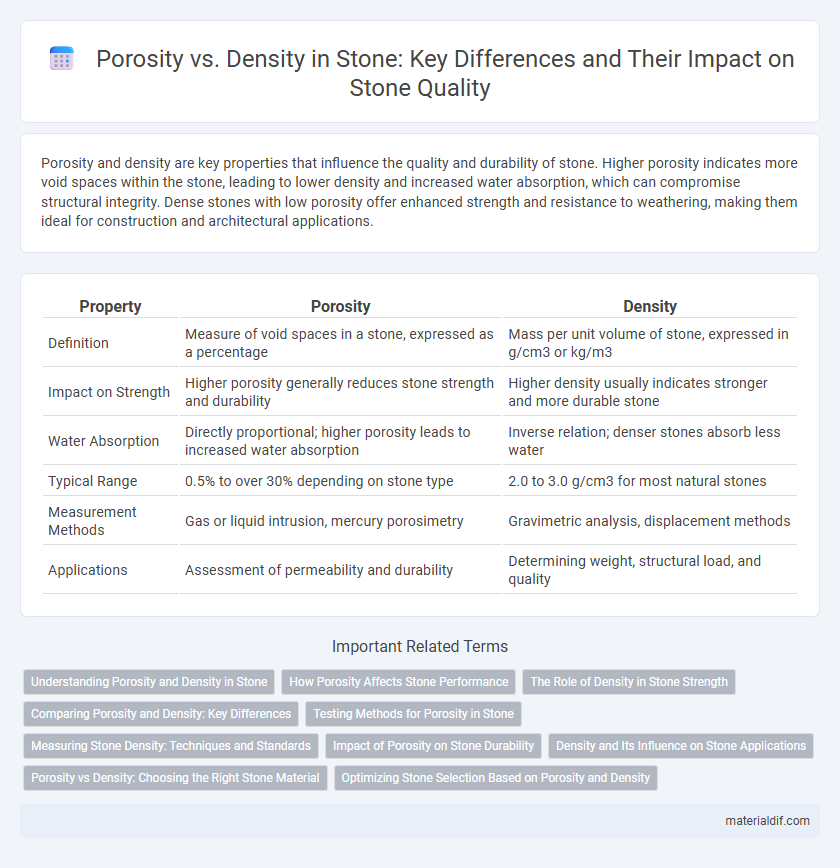Porosity and density are key properties that influence the quality and durability of stone. Higher porosity indicates more void spaces within the stone, leading to lower density and increased water absorption, which can compromise structural integrity. Dense stones with low porosity offer enhanced strength and resistance to weathering, making them ideal for construction and architectural applications.
Table of Comparison
| Property | Porosity | Density |
|---|---|---|
| Definition | Measure of void spaces in a stone, expressed as a percentage | Mass per unit volume of stone, expressed in g/cm3 or kg/m3 |
| Impact on Strength | Higher porosity generally reduces stone strength and durability | Higher density usually indicates stronger and more durable stone |
| Water Absorption | Directly proportional; higher porosity leads to increased water absorption | Inverse relation; denser stones absorb less water |
| Typical Range | 0.5% to over 30% depending on stone type | 2.0 to 3.0 g/cm3 for most natural stones |
| Measurement Methods | Gas or liquid intrusion, mercury porosimetry | Gravimetric analysis, displacement methods |
| Applications | Assessment of permeability and durability | Determining weight, structural load, and quality |
Understanding Porosity and Density in Stone
Porosity in stone measures the percentage of void spaces within its structure, directly influencing its permeability and strength. Density refers to the mass of the stone per unit volume, affecting its weight and durability in construction applications. Understanding the inverse relationship between porosity and density is crucial for selecting appropriate stone materials in engineering and architectural projects.
How Porosity Affects Stone Performance
Porosity directly influences stone performance by determining its ability to absorb water, which impacts durability and weather resistance. Higher porosity stones tend to be less dense, making them more susceptible to freeze-thaw damage and chemical erosion. Optimal density and low porosity enhance structural strength and longevity in construction materials.
The Role of Density in Stone Strength
Density directly influences stone strength by determining the compactness of its mineral grains, which affects its ability to withstand compressive forces. Higher density stones typically exhibit lower porosity, reducing void spaces where fractures may initiate, resulting in enhanced durability and load-bearing capacity. Understanding density helps predict the mechanical performance of stones such as granite, basalt, and sandstone in construction and architectural applications.
Comparing Porosity and Density: Key Differences
Porosity measures the percentage of void spaces in stone, indicating its capacity to absorb fluids, while density quantifies the mass per unit volume, reflecting the stone's compactness and strength. High porosity typically corresponds to lower density, as more pores reduce the overall mass within a given volume. Understanding the balance between porosity and density is essential for applications in construction and natural stone selection, impacting durability and weather resistance.
Testing Methods for Porosity in Stone
Porosity in stone is commonly tested using methods such as water absorption, mercury intrusion porosimetry (MIP), and gas pycnometry, each providing precise measurements of pore volume and size distribution. Water absorption tests involve submerging stone samples to quantify open porosity by measuring weight gain, while MIP provides detailed pore structure by forcing mercury into the pores under pressure. Gas pycnometry measures the volume of the stone excluding open pores by displacement of gas, offering complementary data to density calculations critical for assessing stone durability and strength.
Measuring Stone Density: Techniques and Standards
Measuring stone density involves techniques such as water displacement, gas pycnometry, and helium porosimetry, each providing accurate assessments of a stone's mass-to-volume ratio. Standards like ASTM C97 and ISO 13061 ensure consistent procedures for determining bulk and apparent density, accounting for porosity levels within natural and engineered stones. Accurate density measurement influences durability, strength, and suitability of stones in construction and architectural applications.
Impact of Porosity on Stone Durability
Porosity directly influences stone durability by determining the amount of void spaces within the material, which affects water absorption and freeze-thaw resistance. Higher porosity increases susceptibility to weathering, chemical attack, and structural weakening over time. Stones with low porosity exhibit greater density, resulting in enhanced strength and longevity in construction and natural settings.
Density and Its Influence on Stone Applications
Density directly impacts stone durability, strength, and suitability for construction and ornamental use. Higher density stones typically offer greater resistance to wear, weathering, and mechanical stress, making them ideal for structural elements and high-traffic surfaces. Understanding density variations helps architects and engineers select appropriate stone materials that balance aesthetic appeal with functional performance.
Porosity vs Density: Choosing the Right Stone Material
Porosity directly affects the density and durability of stone materials, with higher porosity indicating greater void spaces and lower density, making stones more susceptible to water absorption and weathering. Dense stones like granite have low porosity, providing enhanced strength and resistance for construction applications, while more porous stones like sandstone require careful consideration for load-bearing uses. Selecting the right stone material depends on balancing porosity and density to ensure optimal performance in structural integrity and environmental exposure.
Optimizing Stone Selection Based on Porosity and Density
Optimizing stone selection requires balancing porosity and density to ensure durability and functionality in construction. Stones with low porosity typically exhibit higher density, enhancing strength and resistance to weathering, making them ideal for load-bearing structures. Selecting stones with appropriate porosity and density levels minimizes water absorption and improves longevity in various environmental conditions.
Porosity vs Density Infographic

 materialdif.com
materialdif.com